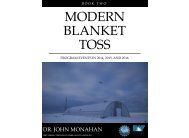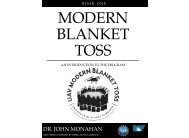Modern Blanket Toss: Findings and Observations
This book is the last in a series of three covering the National Science Foundation awarded Modern Blanket Toss project. In this book are the evaluation findings for each of the three years as well as observations from Modern Blanket Toss staff.
This book is the last in a series of three covering the National Science Foundation awarded Modern Blanket Toss project. In this book are the evaluation findings for each of the three years as well as observations from Modern Blanket Toss staff.
Create successful ePaper yourself
Turn your PDF publications into a flip-book with our unique Google optimized e-Paper software.
2016 FINDINGS<br />
LIMITATIONS OF THE EVALUATION<br />
The results of this evaluation are limited by several factors. First, we rely greatly<br />
on self- reported data. Self-reported data is limited by the fact that it rarely can<br />
be independently verified. Further, self-reported data contain several potential<br />
sources of bias that should be noted as limitations: 1) selective memory<br />
(remembering or not remembering experiences or events that occurred at<br />
some point in the past); 2) telescoping (recalling events that occurred at one<br />
time as if they occurred at another time); 3) attribution (the act of attributing<br />
positive events <strong>and</strong> outcomes to one's own agency but attributing negative<br />
events <strong>and</strong> outcomes to external forces); <strong>and</strong> 4) exaggeration (the act of<br />
representing outcomes or embellishing events as more significant than is actually<br />
suggested from other data). Also, much of the work of this project takes place<br />
during the school year at the remote sites. It is very difficult to assess what<br />
information <strong>and</strong> support was available to students at the different sites, <strong>and</strong> to<br />
what degree the implementation of these supports differed. Additionally, our<br />
sample size is extremely small; it is difficult to describe statistically significant<br />
relationships from the data, as statistical tests normally require a larger sample<br />
size to ensure a representative distribution of the population. Lastly, the impact<br />
of the project on student’s career choices will not be observable until months<br />
or years after the end of data collection (University of Southern California,<br />
2016).<br />
Section 2. Implementation<br />
<strong>Modern</strong> <strong>Blanket</strong> <strong>Toss</strong> participants were drawn from the ranks of UAF Upward<br />
Bound students. Upward Bound is a secondary education program within the<br />
UAF Division of General Studies which works with low-income, high-risk high<br />
school students who are identified as the first in their families to attend college.<br />
<strong>Modern</strong> <strong>Blanket</strong> <strong>Toss</strong>, aligned with the Upward Bound program, had two distinct<br />
components: summer programs held at UAF, <strong>and</strong> school-year implementation at<br />
participating students’ schools.<br />
SUMMER PROGRAMMING<br />
First, a subset of students from the participating Upward Bound sites<br />
participated in a six-week summer program held on the UAF campus. All<br />
participants took two core Upward Bound courses (e.g., language arts,<br />
mathematics, laboratory science, foreign languages, technology skills, study skills,<br />
service learning, <strong>and</strong> financial literacy) as well as <strong>Modern</strong> <strong>Blanket</strong> <strong>Toss</strong> courses<br />
focused on UAVs, geospatial cognition, <strong>and</strong> associated science <strong>and</strong> technology<br />
<strong>and</strong> communication <strong>and</strong> science leadership training.<br />
The first summer program in 2014 focused on flight safety, UAV flying skills with<br />
both simulators <strong>and</strong> quadcopters, <strong>and</strong> collecting data with the UAVs. Students<br />
were given glimpse on the last few days of how the collected photos <strong>and</strong> videos<br />
could be linked to maps on the computer.<br />
In the summer of 2015, there were two afternoon sections devoted to MBT.<br />
One section focused on flying <strong>and</strong> building bigger, stronger UAVs to be used for<br />
data collection <strong>and</strong> the other section focused on GIS skills to use <strong>and</strong> integrate<br />
the collected data. Students in the build section learned about design by<br />
calculating loads <strong>and</strong> lifts as well as h<strong>and</strong>s on wiring, soldering, s<strong>and</strong>ing <strong>and</strong><br />
cutting. Both groups worked together for the last week or so to fly UAVs,<br />
collect photographic data <strong>and</strong> then merge the data into a map.<br />
43




